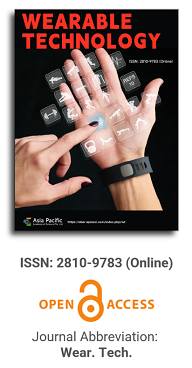

This paper delves deeply into the innovative realm of integrating human emotions with wearable technology. The primary focus is on the conceptualization and development of a kiss transfer device that harnesses the power of wearable technology to bridge the physical gap in human-human interactions. By investigating the intricate nuances of the human-human kissing process, the research seeks to replicate this intimate gesture through a technological medium. The paper not only elaborates on the anatomy, evolution, and hormonal dynamics of kissing but also underscores the transformative potential of wearable technology in capturing and transmitting these intimate moments. This exploration opens up new horizons for long-distance relationships, offering a tangible touchpoint that goes beyond traditional communication methods. Through this pioneering work, the research positions wearable technology as not just a tool for communication but as an extension of our human emotions and expressions.

Overview of smart masks and research on new technology
Vol 2, Issue 2, 2021
Download PDF
Abstract
The smart mask is a new type of mask with active air supply and breathing. It adopts an external electric fan-forced air supply system, which can effectively reduce the user’s breathing load and achieve the purpose of improving comfort and user experience. However, in the current market, the function of smart masks is relatively simple with weak practicability and limited application. Based on these situations and in the research of a large number of smart masks and other types of masks, their application scenarios, advantages and disadvantages of the current technologies used in smart masks are analysed and compared to demonstrate their advantages in comfort and functionality. In terms of application prospects, new technologies can be integrated into the research and development of smart masks, providing new ideas for the research and development of new masks, which is crucial to the future market development of smart wearable products.
Keywords
References
- Ma M, Chen M, Wang D, et al. The development status and prospects of masks. Advances in Textile Science and Technology 2014; (6): 7–11.
- Zheng Y, Shou T. Investigation and analysis on the choice of masks by citizens in haze weather. Scientific Chinese 2015; (18): 142–143.
- TAJ1001–2015 (2015) PM2.5 Protective Masks.
- Zhang S. Research progress of anti-fog and haze green textiles. Tianjin Textile Technology 2017; (6): 50–55.
- YY 0469—2011 (2011) Medical Surgical Masks.
- Chang S, Zhao J. Comparative interpretation of
- medical mask standards in my country. Knitting Industry 2020; (3): 14–17.
- GB 4706.1–2005 (2005) Safety of Household and Similar Electrical Appliances Part 1: General Requirements.
- T/CAQI 63-2019 (2019) Electric Anti-haze Masks.
- Xu G, Li Z. The impact of the “New Coronary Pneumonia” epidemic on my country’s mask industry. Economic and Management Review 2020; (3): 11–20.
- Chen M, Zhou Y, Wang H, et al. Analysis of filtering characteristics and comfort of market masks. Journal of Basic Science of Textile Colleges 2018; 31 (3): 281–288.
- Chen J, Ning N, Jiang Y, et al. Emergency recommendation in West China for the protection of medical staff equipment-related pressure injury under the new coronavirus epidemic. Chinese Journal of Rehabilitation and Reconstruction Surgery 2020; 34(3): 1–5.
- Wang W, Liu C, Zhang X, et al. Design and research of mine powered air follow-up type dust mask. Science and Technology Innovation 2018; (1): 181–182.
- Guan T. Design of a new type of intelligent haze mask. Industrial Control Computer 2017; 30(11): 95–96.
- Guo H, Wu W, Gao Y. Research status and development trend of anti-PM2.5 masks. Technology Wind 2018; (16): 124, 167.
- Pang Y. Intelligent protection: A new generation of anti-haze artefact. Quality and Certification 2017; (8): 91–92.
- Zhang J, Zhang Z (inventors). A Smart Mask. CHN patent. 109,393,604A. 2019 Mar 1.
- Yue H, Chen X (inventors). Solar Electric Mask. CHN patent. 209,749,876U. 2019 Dec. 10.
- Zhang Z, Duan Y, Zhong L, et al. Intelligent Anti-smog Masks for Traffic Police. CHN patent. 208,523,836U, 2019 Feb. 22.
- Qian Z, Liu D. Overview of Bluetooth technology data transmission. Journal of Communications 2012; 33(4): 143–151.
- Wang Y. How much do you know about Bluetooth sound quality. Computer and Network 2019; 45(9): 16–17.
- Luo W. An emerging Bluetooth technology—Ultra low energy Bluetooth technology. Modern Telecommunications Technology 2010; 40(10): 31–34.
- Li J, Liu Z. The development of haze monitoring technology and monitoring system in China. Frontiers in Environmental Protection 2019; 9(2): 116–121.
- Chen S. Research on intelligent detection system of indoor air quality [PhD Thesis]. Harbin: Harbin University of Science and Technology; 2018.
- Lu X, Li T, Jiang K, et al. Research on the transmission of haze detection data by GPRS technology. Intelligent Computer and Application 2017; 7(2): 125–126.
- Liu Y, Sun S, Shi W, et al. A respiratory monitoring system based on wearable devices and smart phones. Beijing Biomedical Engineering 2019; 38(4): 417–423.
- Xue N. Review of flexible wearable pressure sensing devices and their medical applications. Strait Technology and Industry 2018; (6): 29–34.
- Chang F, Yin J, Zhang H, et al. Research and the prospect of wearable health monitoring system. Chinese Journal of Medical Devices 2015; 39(1): 40–43.
- Shen Y. Analysis of semiconductor thermistor temperature sensor. Shanghai Aerospace 1997; (2): 57–60.
- Zhang X, Shi P, Yu H, et al. Realization of wearable physiological signal detection and analysis system. Electronic Technology 2017; 30(9): 65–67.
- Han Y. Principle and summary analysis of several typical humidity sensors. Journal of Jianghan University: Natural Science Edition 2009; 37(1): 33–36.
- Ma L, Wu R, Wang J, et al. Full textile wireless flexible humidity sensor for human physiological monitoring. Advanced Functional Materials 2019; 29(43): 1904549.
- Yang R, Li Q, Liu J. The development trend of high-tech textiles: A brief discussion on the development direction of Tianjin Textile’s “Tenth Five-Year”. Tianjin Textile Technology 2001; (2): 2–6.
- Ge C. Discussion on the development of functional textiles. Tianjin Textile Technology 2015; (1): 1–3.
- He C, Gu Z. Intelligent textiles. Knitting Industry 1999; (4): 48–52.
- Zeng Z, Shen L, Sang P. Research on the design mode of intelligent safety clothing for the network era. Knitting Industry 2019; (3): 64–67.
Supporting Agencies
Copyright (c) 2021 Boyang Zhang, Yuxin Zheng, Yue Qiu, Liu Yang, Runqing Zhang, Yuhao Liao, Jun Xu

This work is licensed under a Creative Commons Attribution 4.0 International License.

Prof. Zhen Cao
College of Information Science & Electronic Engineering, Zhejiang University
China, China
Processing Speed
-
-
-
- <5 days from submission to initial review decision;
- 62% acceptance rate
-
-
Asia Pacific Academy of Science Pte. Ltd. (APACSCI) specializes in international journal publishing. APACSCI adopts the open access publishing model and provides an important communication bridge for academic groups whose interest fields include engineering, technology, medicine, computer, mathematics, agriculture and forestry, and environment.





